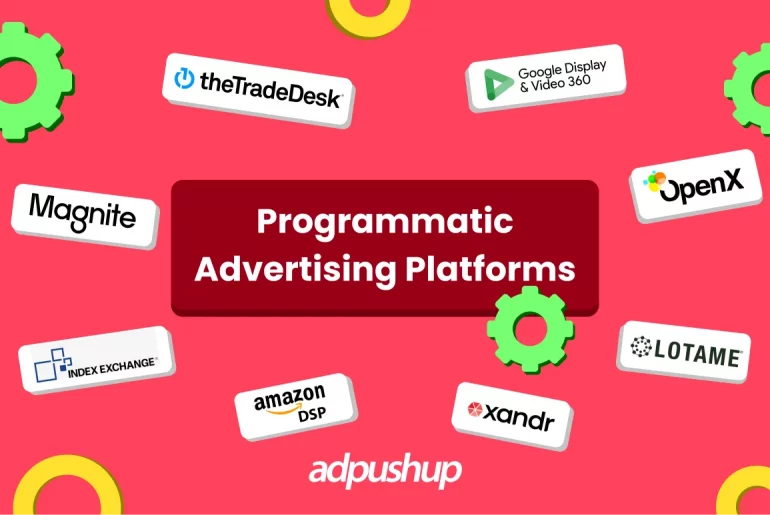Choose the best programmatic advertising platforms in the ad tech industry and make the most out of your ad inventory.
Programmatic advertising is transforming the digital advertising environment and is essential in optimizing ad spend. According to Custom Market Insights (CMI), the Programmatic Advertising Market is predicted to have been worth USD 2 billion in 2022 and USD 30.1 billion by 2032, with a compound annual growth rate (CAGR) of 35% from 2022 to 2032.
In this blog, we will dive deep into the programmatic advertising companies we hand-picked that you should consider while selecting one.
What is a Programmatic Advertising Platform?
A programmatic advertising platform is software that enables a publisher or advertiser to participate in programmatic advertising. These platforms can do both: connect you to the programmatic advertising ecosystem or complement the ad space transaction process. Many types of programmatic advertising platforms exist, such as ad exchanges, ad networks, supply-side platforms, demand-side platforms, data management platforms, etc.
Depending on the usage, these tools use automation to perform several functions: facilitate ad space buying/selling, collect, analyze, and store user data, and participate in the real-time bidding process, among other tasks.
What Criteria Did We Use to Choose the Top Programmatic Advertising Platforms?
Choosing the top programmatic advertising platforms of 2025 was a challenging task.
With so many options available, we had to carefully evaluate each platform based on various criteria to determine which ones deserved to make the cut to the list.
Here are the main criteria we used to make our selection for the best programmatic advertising platforms:
- Features
- Strengths
- Weaknesses
- Payment model
- Ad formats
- Data capabilities
- Privacy compliance
AdPushup: A Reliable Programmatic Advertising Platform
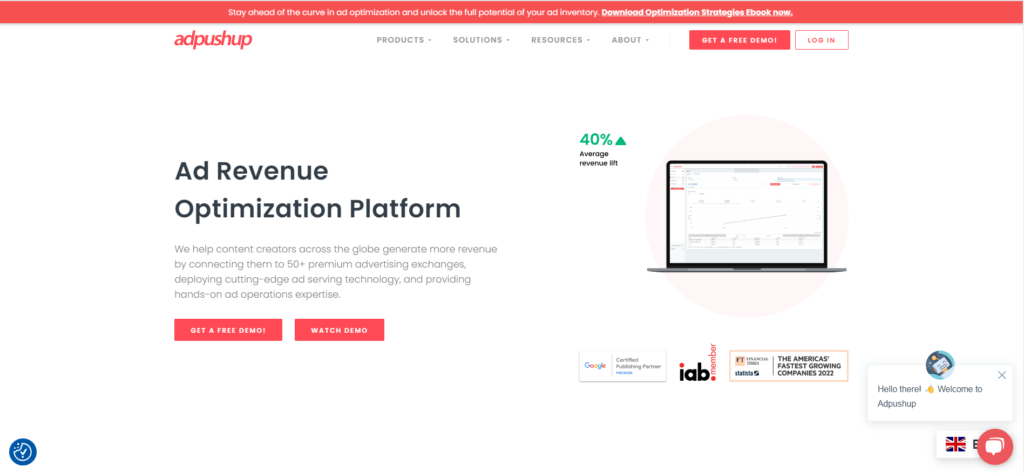
Before coming to the top 12 programmatic advertising platforms, let us introduce you to AdPushup – a publisher-oriented programmatic advertising platform that helps publishers build relationships with advertisers, manage their ad stack, and optimize ad layouts.
We are one of the very few ad partners in the market that provide individualized assistance from ad ops to all our publishing partners, irrespective of their revenue or size.
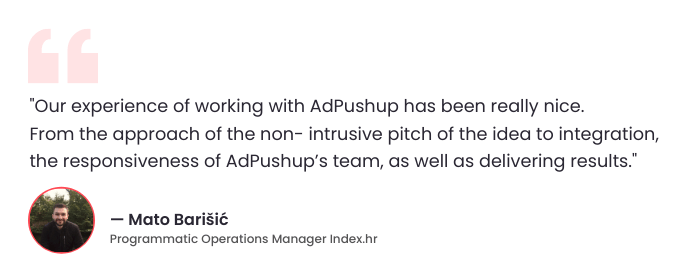
Features
- Pioneer in deploying A/B testing for ads
- Conducts thorough analysis of publisher’s digital assets to curate personalized ad revenue strategies
- Works with +30 verified and premium demand partners
Strengths
- User-friendly interface that can be easily navigated by publishers
- Offers AdBlock recovery feature to regain the lost revenue
- Offers innovative ad formats like butterfly ads to enhance visibility and CTR
Weaknesses
- Publishers must have $3000 monthly revenue to be eligible for AdPushup
Ad Formats Offered
- IAB Standard Ads
- Sticky Ads
- Native Ads
- Video Ads (In-stream/Out-stream)
- Docked-in Ads
- In-image Ads
- In-view Ads
And many more.
Payment Model
Flexible and customizable payment models (CPM-model and revenue-sharing model both)
Top 12 Programmatic Advertising Platforms of 2025
After careful evaluation, we’ve identified the top 12 programmatic advertising platforms by category.
Each platform offers unique features, benefits, and payment options and will provide value for businesses and marketers looking to maximize their ad performance.
Here’s a detailed overview of each platform:
1. Demand-side Platforms
Demand-side platforms are used by advertisers to take part in the programmatic advertising process: real-time bidding, optimizing bids in real-time, collecting user data, and managing ad campaigns, among other aspects.
Here is a comparative table showcasing the differences between our three chosen DSPs: The Trade Desk, Google DV 360, and Amazon DSP.
| Criteria | The Trade Desk | Google Display & Video 360 (DV360) | Amazon DSP |
| User Interface | User-friendly interface but doesn’t suit all publishers | Perceptive and user-friendly; best for beginners | Streamlined, prioritizing ease of use |
| Data Integration | Extensive third-party data integrations | Integrates with Google Marketing Platform | Combines first-party data and AI for deeper insights |
| Audience Targeting | Advanced targeting options including behavioral and geographic | Sophisticated targeting with custom audiences and remarketing | Targeting based on Amazon’s unique audience signals |
| Supported Ad Formats | Display, video, audio, and connected TV | Display, video, audio, native, digital-out-of-home | Display, video, audio, streaming TV |
| Payment Model | CPM + PoM | CPM Payment Model, generally higher for premium placements | CPM |
| Analytics & Reporting | Detailed reporting with performance metrics but can be more granular | Advanced analytics and potent reporting capabilities | Transparent reporting with AI-driven insights |
| Anti-fraud/Safety Measures | Pre-bid and post-bid fraud detection; brand safety measures | Adequate brand safety measures; control over ad placements | Privacy-centric measures and fraud prevention strategies |
1. The Trade Desk
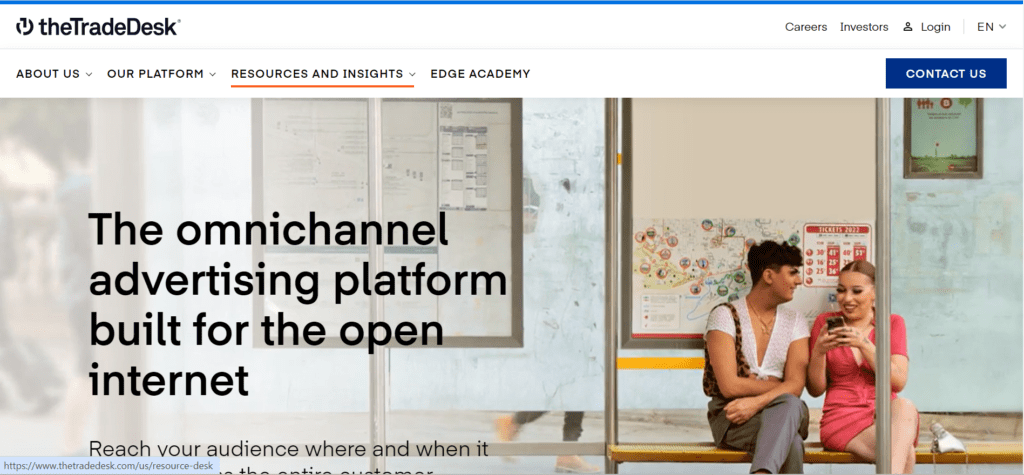
One of the most popular DSPs globally, the Trade Desk is known for its advanced targeting options and cross-channel buying capabilities. The platform supports display, video, connected TV, and audio, making it a versatile choice for advertisers looking to access multiple channels with precision.
- Features: Omnichannel advertising, real-time bidding, enterprise API for custom development
- Strengths: Integration with leading global data, comprehensive programmatic media tools, impressive data management techniques, broad audience reach
- Weakness: Lack of transparency in Payment Model structure, limited reporting capabilities, less user-friendly, lax customer support
- Payment Model: Hybrid model (CPM+percentage of media cost)
- Ad formats: Display ads, native ads, video ads, audio ads, expandable ads, CTV.
2. Google Display & Video 360 (DV360)
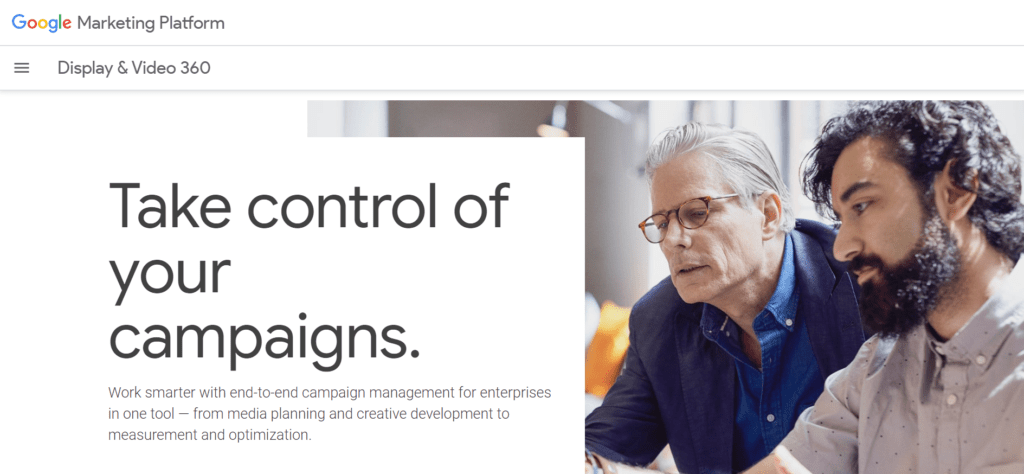
As part of Google’s suite, DV360 offers integration with Google’s data and tools, giving advertisers a wide range of ad formats and channels, as well as detailed reporting. Its access to Google’s ecosystem makes it a powerful tool for targeted programmatic buying.
- Features: Real-time bidding, sophisticated targeting, access to Google Display Network.
- Strengths: User-friendly interface, detailed audience insights, simultaneous audience and campaign management, brand safety measures
- Weakness: Expensive, not suitable for smaller businesses or advertisers with a limited budget, complex reporting.
- Payment Model: CPM model.
- Ad formats: Video (in-stream, in-search, in-display, native videos), Banner (interstitials, native display, swirl, parallax), audio, native, DOOH (digital-out-of-home).
3. Amazon DSP
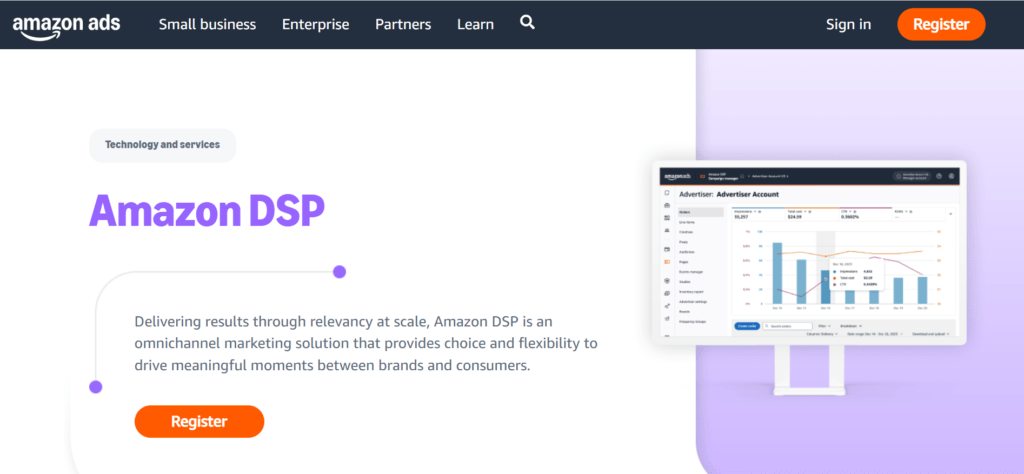
Amazon DSP excels in targeting based on shopping behaviors. It can access Amazon’s first-party data, enabling highly accurate targeting, especially for e-commerce brands. It covers display, video, and audio advertising.
- Features: Real-time bidding, sophisticated targeting, unique ad space supply like on Audible and IMDb.
- Strengths: Automated campaign price adjustment based on ad space, greater reach, robust customer insights.
- Weakness: Not suitable for smaller brands due to significant financial investment, DSP setup requires ongoing management and effort.
- Payment Model: CPM model.
- Ad formats: Static ads, video ads, display ads, audio ads, streaming TV ads.
2. Supply-side Platforms
Supply-side platforms are used by publishers to manage several programmatic advertising processes like managing ad inventory, optimizing floor prices, and selecting which advertiser to work with, among other operations.
Here is a comparative table showcasing the differences between our three chosen SSPs: Pubmatic SSP, Magnite SSP, and OpenX SSP.
| Criteria | PubMatic | Magnite | OpenX |
| User Interface | Modern, user-friendly UI | Intuitive UI for header bidding and reporting | Clean and efficient interface, user-friendly dashboard |
| Data Integration | Wide range of data partners for comprehensive insights | Integrates with DMPs and allows audience data management | Built-in ID resolution; integrates with various demand partners |
| Audience Targeting | Advanced targeting via Connect platform; includes cookie-alternative strategies | Enables audience segmentation and synchronization using Magnite DMP | Customizable targeting options; real-time bidding enhances audience reach |
| Supported Ad Formats | Display, video, mobile, native, CTV, OTT, addressable | CTV, video, mobile, display, audio, native, DOOH | Supports diverse formats including CTV, video, mobile, and display |
| Payment Model | Revenue sharing | Revenue sharing | 14% of publisher’s revenue |
| Analytics and Reporting | In-depth reporting with real-time analytics | Real-time customized reporting and detailed performance analysis | Robust analytics tools providing insights into campaign performance and revenue metrics |
| Anti-Fraud/Safety Measures | Implements a fraud-free program; real-time scanning and partnerships for audience protection | Dedicated IQ team for brand safety; pre- and post-impression fraud monitoring | Employs third-party viewability vendors; advanced measures to mitigate fraud and ensure brand safety |
1. PubMatic
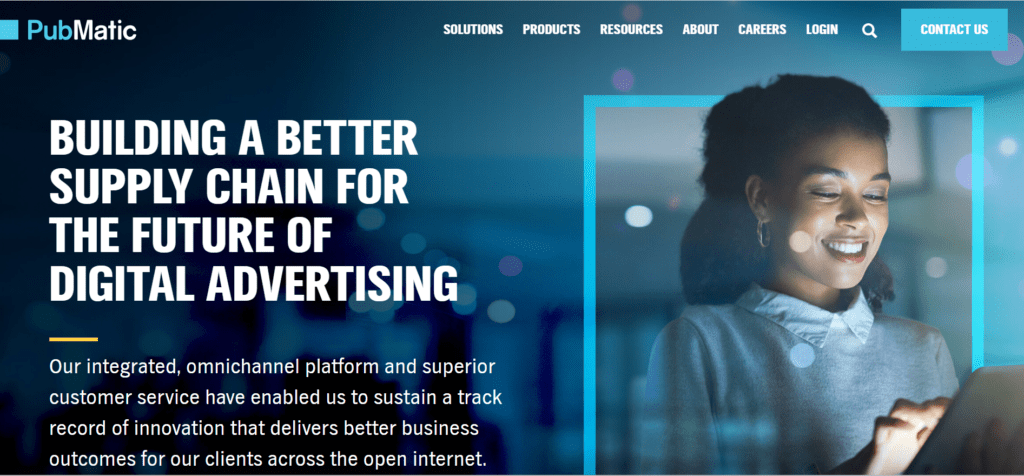
A leading SSP known for its transparency and focus on quality inventory, Pubmatic offers real-time bidding and header bidding solutions to maximize publisher revenue. PubMatic is famous for combating ad fraud and ensuring clean ad inventory.
- Features: Omnichannel monetization, ad quality tools and malware detection, OpenBid SDK for higher demand
- Strengths: Detailed inventory insights, private marketplaces for premium ad placements, optimized access to bids
- Weaknesses: Inadequate customer support, complex implementation of SSP with mobile ad servers,
- Payment model: Revenue-sharing model.
- Ad formats: Display ads, video ads, mobile ads, CTV ads
2. Magnite
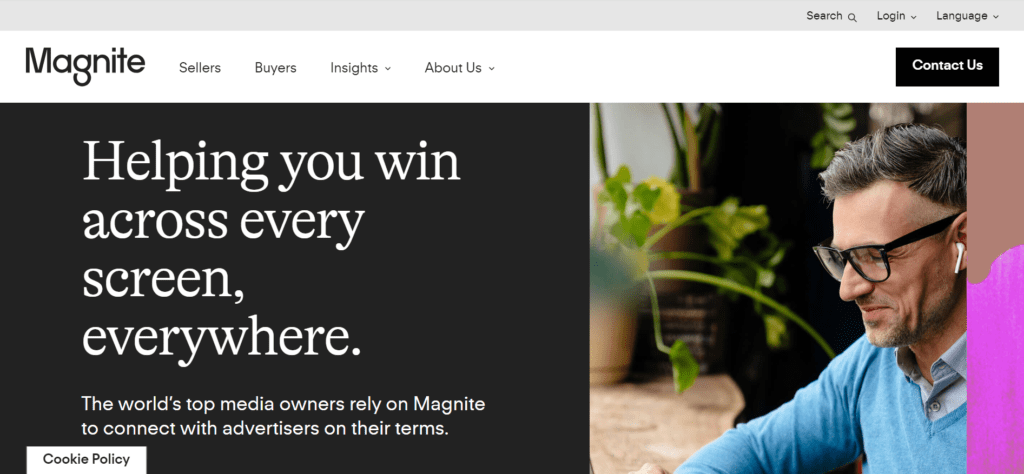
Created from the merger of the Rubicon Project and Telaria, Magnite is a significant player in the SSP space. It focuses on delivering high-quality video, display, and connected TV (CTV) inventory. Magnite also supports programmatic direct and open auction models, offering flexibility to publishers.
- Features: Clean supply ecosystem, offer open RTB, programmatic deals, private marketplaces
- Strengths: Ideal for small-size publishers, no setup fee, excellent client support
- Weaknesses: Delay in data report updation, UI can be slow at times, reporting portal cuts off the bid request data after some time.
- Payment Model: Publishers fee is 4% higher than the market rate; revenue sharing
- Ad formats: Banners ads, interstitial ads, in-stream and out-stream video ads, rewarded video ads, tiles, and pause ads
3. OpenX
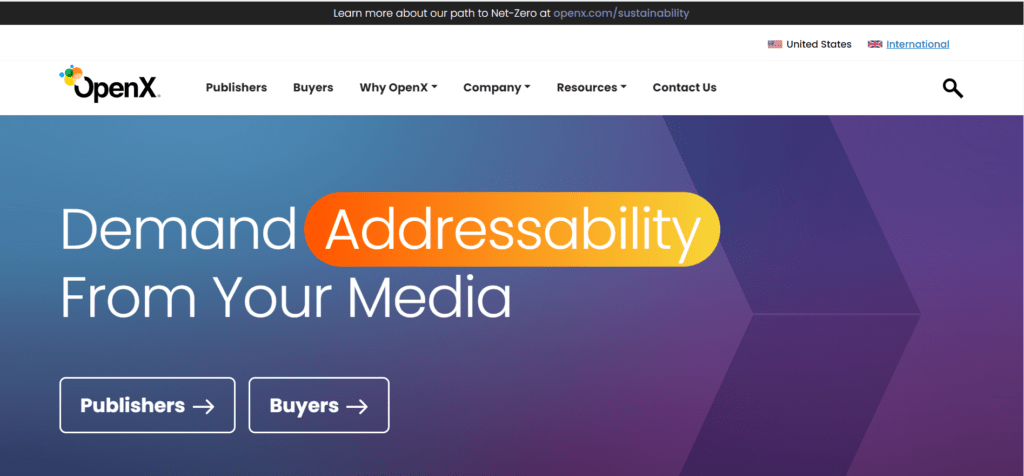
OpenX provides a highly scalable SSP platform recognized for its speed and premium ad inventory. It offers auction and programmatic direct models, and its focus on premium publishers makes it a favorite among brands seeking high-quality audiences.
- Features: Offers programmatic deals, OpenX Bidder for third-party bidding,
- Strengths: Video monetization solutions, real-time bidding, nuanced targeting
- Weaknesses: Less control over ad placements,
- Payment Model: 14% of publisher’s revenue
- Ad formats: Display ads, mobile ads, video ads, CTV ads
3. Ad Exchanges
Ad exchanges are a digital matchmaker between publishers and advertisers that facilitates real estate advertising transactions.
Here is a comparative table showcasing the differences between our three chosen ad exchanges: Google AdX, Xandr, and Index Exchange.
| Criteria | Google AdX | Xandr (AppNexus) | Index Exchange |
| User Interface | Instinctive but may experience latency | Complex for beginners | Straightforward and user-friendly |
| Data Integration | Integrates with Google Ad Manager; extensive partner network | Rich partner ecosystem, integrates with AT&T data | Business Intelligence platform with real-time data |
| Audience Targeting | Advanced targeting by demographics, interests, behavior | Robust audience analysis; targets by demographics and behavior | Custom targeting options; 3 Identity offerings |
| Supported Ad Formats | Video, display, mobile | Display, video, audio, mobile, native, CTV | Display, video, mobile, native, audio |
| Payment Model | Primarily CPM; no upfront fees for publishers | CPM, CPC, CPA; customizable Payment Model | Flexible; may lack transparency in Payment Model structures |
| Analytics and Reporting | Comprehensive reporting and analytics tools | Detailed insights and analytics dashboard | Real-time insights with a focus on performance |
| Anti-fraud/Safety Measures | Account-level filtering, sensitive category blocking | Privacy policies and content prohibitions; partners with clean.io | Partners with multiple safety organizations for fraud prevention |
1. Google AdX (Google Ad Exchange)
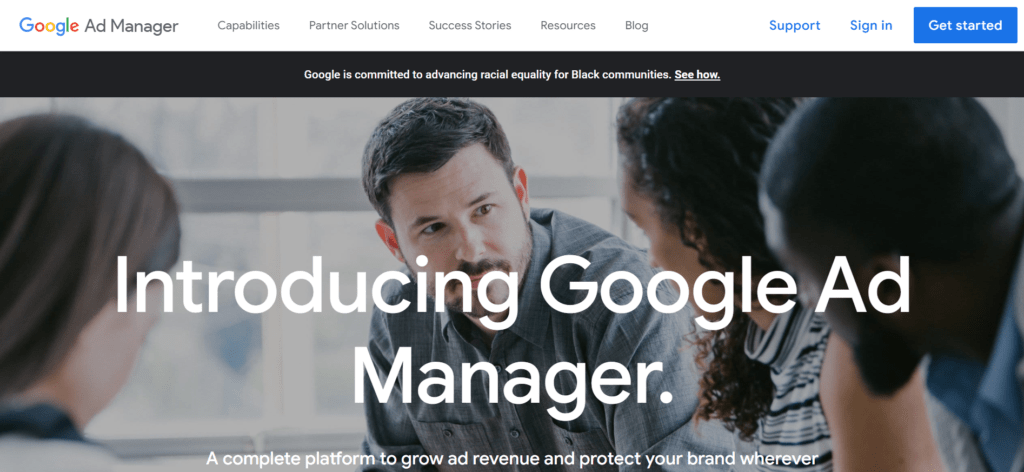
The largest and most well-known ad exchange, Google AdX, offers access to high-quality inventory across Google’s vast network. It operates transparently and provides a wide range of targeting options, making it a preferred choice for buyers and sellers.
- Features: Wide pool of premium advertisers
- Strengths: Access to both Google-certified and non-google certified demand partners, in-built blocking and filtering features
- Weaknesses: Can be joined by invitation only, risk of inventory overlap, requires technical expertise to maintain the account
- Payment Model: CPM
- Ad formats: Responsive ads, video ads, rich media ads, display ads
2. Xandr (Microsoft Advertising)
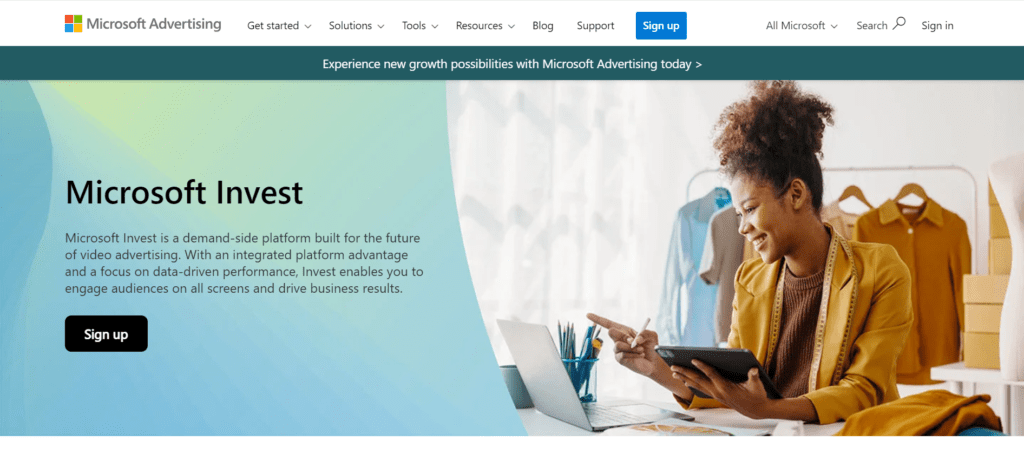
Xandr, now part of Microsoft Advertising, is known for its flexible and scalable ad exchange technology. It provides real-time bidding and has a robust video and display ads presence. It also emphasizes data security and transparency, which are critical for advertisers and publishers.
- Features: Board demand, multiple customization options, robust inventory and campaign management
- Strengths: Advanced advertising solutions, great customer support, and provides high CPM
- Weaknesses: Can’t auto-optimize budgets in-between tactics, expensive, complex interface
- Payment Model: CPM, CPC, CPA
- Ad formats: Banner ads, display ads,
3. Index Exchange
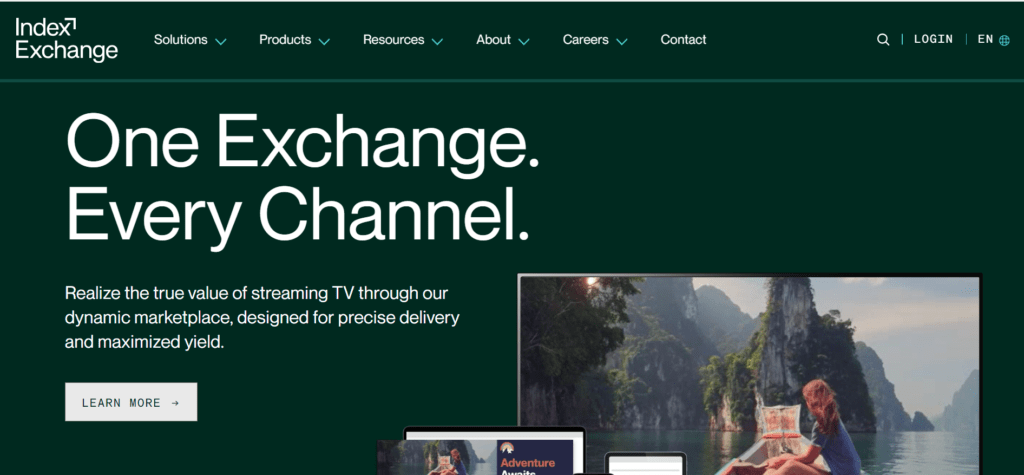
A transparent and fair ad exchange that provides premium inventory for brands and agencies, Index Exchange is highly regarded for its header bidding solutions and its focus on enabling publishers to maximize their ad revenue. What makes Index Exchange an excellent programmatic advertising platform are the various functionalities that are specifically designed for precise ad delivery and maximized yield for publishers.
- Features: Client Audit Log for transparency in transactions, predictive intelligence for facilitating ad space transactions, custom targeting options
- Strengths: High-tech monetization tools, no minimum traffic requirements, omnichannel advertising
- Weaknesses: Have been called out for bid caching
- Payment Model: Flexible
- Ad formats: Banner ads, video ads, display ads, CTV ads, native ads
4. Data Management Platforms
A data management platform is software designed to collect, filter, and unify user data collected across various sources. It uses sophisticated algorithms for data analysis to create a complete user profile of your consumers.
Here is a comparative table showcasing the differences between our three chosen DMPs: Lotame, Adobe Audience Manager, and Salesforce Data Cloud.
| Criteria | Lotame | Adobe Audience Manager | Salesforce Data Cloud |
| User Interface | User-friendly but can be sluggish at times. | Simple and easy to navigate, though integrating with non-Adobe tools can be challenging. | Intuitive interface, integrates well with external systems. |
| Data Capabilities and Integration | Combines first-party, second-party, and third-party data; seamless exchange with other publishers. | Integrates with Adobe Experience Cloud and third-party solutions; collects data from multiple sources. | Unifies data from CRM, web analytics, social media, and third-party providers; deep integration with Salesforce products. |
| Data Quality Management | Focus on first-party data enrichment and identity resolution; offers tools for audience insights. | Advanced audience segmentation and data cleansing features powered by Adobe Sensei. | AI-powered tools for building precise audience segments; automated compliance with data privacy regulations. |
| Security and Compliance | Strong emphasis on privacy; cookieless strategies; uses the Lightning Tag for secure tracking. | Built-in compliance measures as part of Adobe’s ecosystem; focuses on data governance and user privacy. | Automated compliance features to meet global data privacy regulations; built-in consent management platform. |
| Cost and Payment Model Structure | Custom Payment Model based on features and usage; adaptable for various business needs. | Payment Model details available upon request; typically aligned with Adobe’s enterprise-level offerings. | Payment Model varies; designed for enterprise-level needs, usually requiring significant investment. |
| Data Analytics and Reporting | Provides in-depth reporting and analytics to understand audience behavior; tools for data visualization. | Offers advanced analytics for audience segments and real-time insights; integrates well with other Adobe analytics tools. | Strong reporting capabilities with automated insights based on incoming data; robust data analysis features. |
1. Lotame
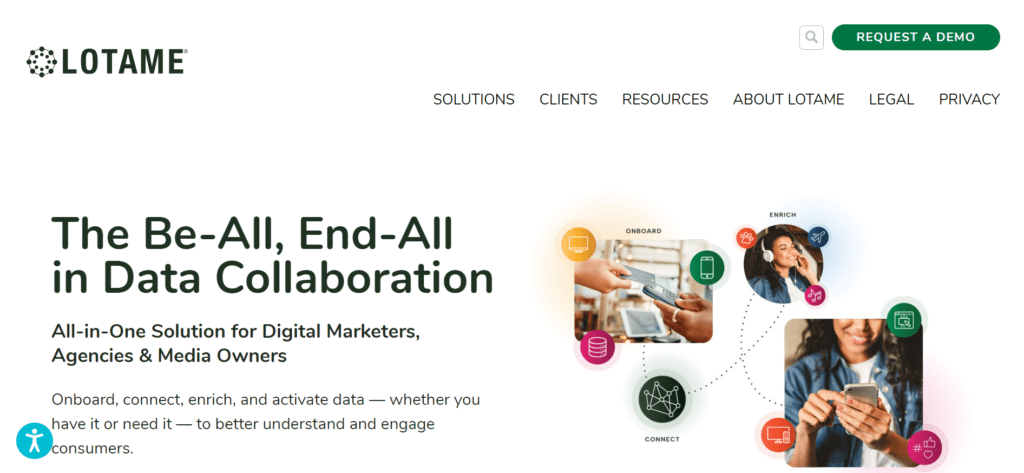
Lotame is one of the most widely used independent programmatic advertising platforms. It helps advertisers and publishers manage and activate their audience data across multiple channels. It provides rich audience insights and supports third-party data integration for enhanced targeting.
- Features: Cookieless targeting, customized service model, import/export data from many sources
- Strengths: User-friendly UI, robust data unification, strong data comparison capabilities
- Weaknesses: Expensive, UI can be a bit slow at times, dashboard can offer more visualization
- Data capabilities: Works with second-party and cookieless data
- Privacy compliance: Limits collection of personal data, provides opt-in/opt-out features to customers, stringent policies to manage personal data incidents
2. Adobe Audience Manager
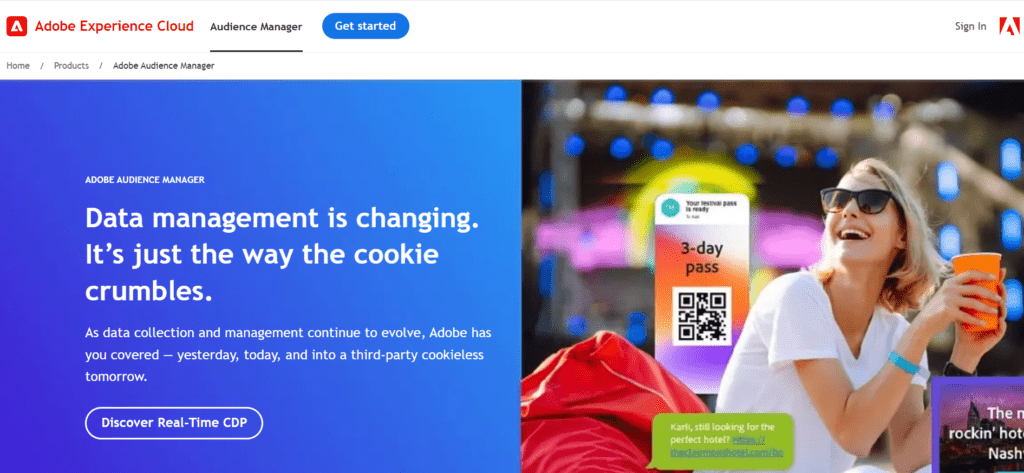
Part of Adobe’s marketing cloud, this Adobe Audience Manager helps brands unify data from various sources to create personalized experiences. Its integration with Adobe’s suite of marketing tools makes it a powerful choice for advertisers seeking a comprehensive approach to audience segmentation and targeting. The DMP’s advanced data structuring abilities and robust data gathering capabilities make it one of the best programmatic advertising platforms in the market.
- Features: Provides complete customer profile, advanced audience segmentation, real-time data analysis
- Strengths: Sophisticated reporting techniques, flexibility around data organization, offers A/B testing
- Weaknesses: Navigation issues with AAM’s mobile version, lags with UI loading, integration issues with non-Adobe platforms
- Data capabilities: Uses machine learning and AI to discover new audiences
- Privacy compliance: Doesn’t allow data that can directly identify a user, deletes data after 120 days of inactivity, users can access or delete their data through Adobe Experience Privacy Platform Service
3. Salesforce Data Cloud
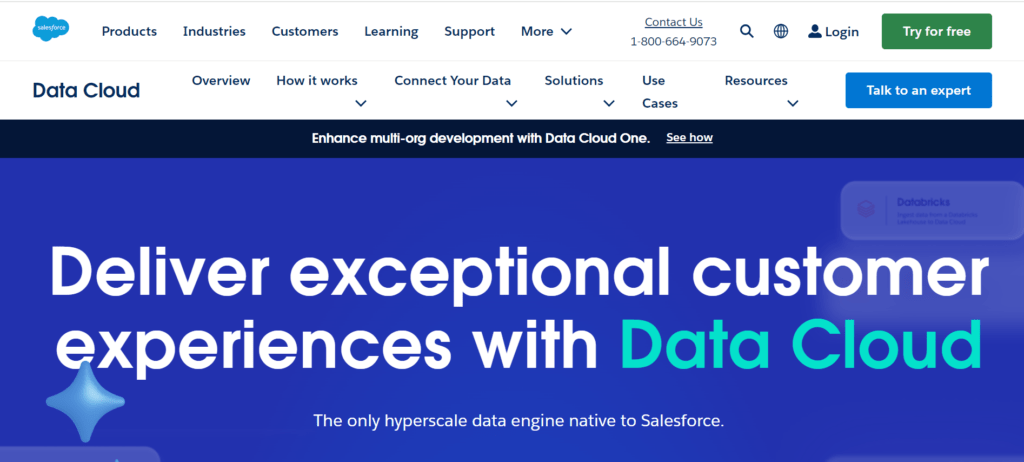
Salesforce Data Cloud allows brands to collect, unify, and activate their audience data to give a 360-degree review of their consumers. A successor of Salesforce Audience Studio, the integrated platform combines data, AI, and CRM to personalize customer experience, making it an ideal programmatic advertising platform. It integrates well with other Salesforce products and offers robust capabilities for data-driven marketing, making it ideal for larger enterprises.
- Features: Uses Einstein AI to combine data and search for customized content, visual representation of data model, robust profile unification
- Strengths: Real-time activation of audience data, expensive
- Weaknesses: Expensive, lengthy implementation process, data updation limited to once an hour, challenging segmentation interface
- Data capabilities: Data acquisition from various sources like data lakes and warehouses without data duplication
- Privacy compliance: Have security programs to safeguard user data, GDPR compliant
With the list of programmatic advertising platforms covered, it’s time to understand their mechanics and how to pick the right platform for your goals.
How Does a Programmatic Advertising Platform Work?
Programmatic advertising is an evolution of traditional advertising. The advertising work earlier done by humans is now being automated using sophisticated software called programmatic advertising platforms.
When a user visits a website, the Supply Side Platform (SSP) sends a signal to the ad exchange, notifying it of an available ad space. The ad exchange then sends a bid request to all the demand partners like agencies, ad networks, etc.
If the bid request matches the advertiser’s pre-defined campaign parameters, demand partners bid on the impression, with the highest bidder getting to present their ad. This process, hardly taking a fraction of a second, is done via real-time bidding.
Which Programmatic Advertising Platform should you choose?
With a plethora of options available, choosing the perfect programmatic advertising platform would require a thorough understanding of your needs.
Consider this. Does the programmatic buying platform give you the reach you aim for? Does it work with premium publishers or advertisers? What are the options in marketplaces? How do I want my data to be collaborated?
Ask yourself these questions before zeroing in on one. We have also listed some factors you should consider in addition to the aforementioned questions.
1. Interface
Depending on your technological proficiency, you can select a platform that’s easy to understand and use. The best way to assess this is to get a free trial or a demo. In our opinion, always opt for platforms that provide a simple and unified interface to find all the required functionalities in one place.
2. Payment model
The pricing structure is one of the most defining elements of a programmatic advertising platform. Emphasize the following questions:
- What payment do they follow: revenue-sharing or CPM/CPC model?
- What is their payment cycle: 30 days, 45 days, 60 days, or something else?
- Does the platform have a threshold for the payment to begin?
- What mode of payment do they follow?
3. Advertisers’ pool
Brand safety is paramount, thus, platforms that offer a broad range of advertisers, especially the premium ones, should be on top of your list. This maintains your brand reputation and increases ad engagement rates among your audience.
4. Transparency
Aim for a platform that emphasizes transparency so you know what ads and where they are being placed on your website. Moreover, this will also ensure that the platform is unambiguous with you regarding the payment structure.
5. Support
One of the building blocks of a great programmatic advertising company is its customer support. Are they friendly and proactive? Is their technical support efficient and resolves issues timely? Are they reachable? These factors are especially important when you encounter any technical difficulties.
Benefits of Programmatic Advertising Platforms
Numerous benefits come with a programmatic advertising platform. From streamlining ad campaigns to managing ad space – it makes the whole advertising process seamless. Here are some benefits of programmatic advertising platforms that you should look out for:
1. Razor-sharp Targeting Capabilities
Programmatic advertising platforms come with advanced functionalities like demographic, behavioral, or contextual targeting to target the audience to the grain. These targeting capabilities align the ad serving with the user’s interests, leading to higher CTR and, subsequently, high eCPM.
2. Increased Efficiency
Since programmatic advertising platforms automate ad buying/selling by optimizing the ad placement process, publishers can devote more time to data analysis and ad revenue strategies through it. Apart from this, these platforms also use the redundant ad space, and bring in more advertisers to bid on them, generating more revenue for the publishers.
3. Higher ROI
Publishers and advertisers invest in their platforms to make the best out of the programmatic advertising demand. Both use data from the programmatic advertising platforms to analyze the ad space and campaign performances, identify opportunities, tweak their strategies, and generate higher revenue. These platforms also offer step-by-step optimization to utilize the campaign budget most effectively.
Challenges of Programmatic Advertising Platforms
While programmatic advertising has been projecting strong growth in many markets, it comes with its challenges, such as:
1. Data Privacy Issues
Programmatic advertising uses user data, from users’ online behavior to demographics, for nuanced targeting. And many times, that data is collected without consent, raising data privacy issues. Moreover, stringent privacy laws and Google’s planning to phase out third-party cookies can impact how programmatic advertising functions.
2. Ad Fraud
Ad fraud occurs when an ad garners fake impressions,i.e., impressions left on the ad by bots, which happens when a website attracts bot or fake traffic. As a human does not see the ad, the chances of clicks or conversions will be meager. Bot traffic can also lead to skewed metrics—for example, high impressions but low CTR or conversions.
3. Ad Viewability
One of the significant concerns that the industry faces is low ad viewability due to the growing use of ad blockers. These ad blockers can waste a major portion of the advertiser’s budget. Moreover, irrelevant ads can also be placed on the website, which may not be favored by the users, leading to a downfall in website traffic.
Final Thoughts on Programmatic Advertising Platforms
Programmatic advertising is an effective means of connecting and interacting with your intended audience.
With the help of programmatic advertising platforms, you can optimize your ad inventory and maximize ad revenue generation. Moreover, programmatic advertising companies provide advanced AI-based functionalities, such as optimizing bids or floor prices in real-time and using in-depth targeting features.
Choosing one of the best programmatic ad platforms will make your advertising process efficient and provide more time for strategizing.
As a business owner or marketing professional, it is essential to carefully consider the programmatic advertising platforms available in 2025 to determine which ones are the best fit for your needs.
AdPushup, a result-oriented ad partner, is a one-stop solution for publishers looking to grow their ad revenue. We deploy sophisticated ad revenue optimization techniques to scale up a publisher’s business without compromising on the UX. Focus on your business, leave ad ops to the experts. Sign up here for more information.
Frequently Asked Ques
Programmatic advertising is a type of digital advertising that uses automated technology to buy and sell ad inventory in real-time. It allows advertisers to target specific audiences based on demographics, interests, and online behavior.
Using a programmatic advertising platform can offer a range of benefits, including advanced targeting options, real-time bidding, custom reporting, and ease of use. It can also help advertisers reach their target audience more effectively and efficiently and maximize the ROI of their ad campaigns.
When choosing a programmatic advertising platform, it’s important to consider features, ease of use, customer support, pricing, and user reviews. You should also consider your goals, budget, and target audience and choose a platform that fits your needs.
Programmatic advertising platforms use various techniques to detect and prevent ad fraud, including fraud detection algorithms, third-party verification services, and real-time monitoring. Advertisers can also protect themselves against ad fraud by setting viewability thresholds and using reputable ad networks.
Xandr is a multifaceted platform that can function as a DSP (Xandr Invest) and SSP (Xandr Monetize). Moreover, Xandr Community is a marketplace that can only be accessed by publishers and advertisers using Xandr’s SSP or DSP.

